Arto's Blog
Pages: << 1 2 3 4 ...5 ...6 7 8 ...9 ...10 11 12 ... 27 >>
Introducing Germaine
Posted: 2013-12-20 21:55:00, Categories: Travel, General, Germany, 398 words (permalink)
 Let us introduce Germaine, our new furry companion. She likes to lie
down and relax, not worrying too much about what's happening in the
world. She follows us around in the flat and knows how to get food
and attention. She miaows or squeeks in a special way, lifts her tail up and
vibrates it. She has hurt her tail at some earlier time in life and
cannot move the last part, so it forms a funny looking arc. When not
eating, Germaine's favourite place is on the bed. Sounds like a
comfortable and easy life, doesn't it?
Let us introduce Germaine, our new furry companion. She likes to lie
down and relax, not worrying too much about what's happening in the
world. She follows us around in the flat and knows how to get food
and attention. She miaows or squeeks in a special way, lifts her tail up and
vibrates it. She has hurt her tail at some earlier time in life and
cannot move the last part, so it forms a funny looking arc. When not
eating, Germaine's favourite place is on the bed. Sounds like a
comfortable and easy life, doesn't it?
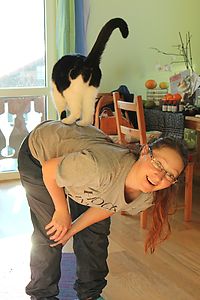 Germaine spent her first 15 years with an elderly lady,
who passed away a few months ago. She needed a new home and we
decided to offer ours. It took her a while to get used to us and the
new environment, but now it feels like she had always been here.
For her age, equivalent to around 75 human years, she's quite fit.
She suffers from digestion problems, needs special food and
medicine, but otherwise she seems to be a happy cat.
Germaine spent her first 15 years with an elderly lady,
who passed away a few months ago. She needed a new home and we
decided to offer ours. It took her a while to get used to us and the
new environment, but now it feels like she had always been here.
For her age, equivalent to around 75 human years, she's quite fit.
She suffers from digestion problems, needs special food and
medicine, but otherwise she seems to be a happy cat.
We don't have a garden where Germaine could go out, but she is anyway not used to it after spending all her life indoors. When we open the balcony door, she may shortly step outside to smell fresh air, but comes soon back in. First we were careful as we thought she might jump down on the neighbour's balcony, but she doesn't seem to even consider that. An even if she would, it wouldn't be too bad as the neighbour below us likes cats too.
 After returning from Thailand and Laos in May, Sandra has been
working again, this time in a laboratory together with her best
friend. I spent a couple of months in Finland during the summer and
after that I've had various small projects like renovating our
balcony. We also bought a wood oven so we can enjoy watching flames
and keep our flat warm without being dependent on oil.
After returning from Thailand and Laos in May, Sandra has been
working again, this time in a laboratory together with her best
friend. I spent a couple of months in Finland during the summer and
after that I've had various small projects like renovating our
balcony. We also bought a wood oven so we can enjoy watching flames
and keep our flat warm without being dependent on oil.
It looks like we'll spend at least the winter and early spring mostly here in Germany. A hint to our friends: if you've been thinking of visiting us, now would be a good time! Sooner or later we'll probably go travelling again and will also need to find someone to take care of Germaine. However, for now she's living here with us and bringing us joy.
Sabai dii Pi Mai Lao
Posted: 2013-04-30 14:00:28, Categories: Travel, Cycling, Laos, 903 words (permalink)
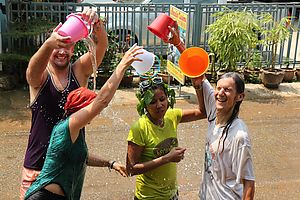 In Mid-April, in the town of Vang Vieng, we attended the cheerful
celebration of Pi Mai Lao, the Lao New Year. Hundreds of people poured
small buckets of water over us, wishing us Happy New Year. We joined
the teams by the roadside and did our own share of watering people
passing by. Beer Lao was generously offered to friends and strangers
alike, music was played from large loudspeakers all around the town
and everybody had a great time.
In Mid-April, in the town of Vang Vieng, we attended the cheerful
celebration of Pi Mai Lao, the Lao New Year. Hundreds of people poured
small buckets of water over us, wishing us Happy New Year. We joined
the teams by the roadside and did our own share of watering people
passing by. Beer Lao was generously offered to friends and strangers
alike, music was played from large loudspeakers all around the town
and everybody had a great time.
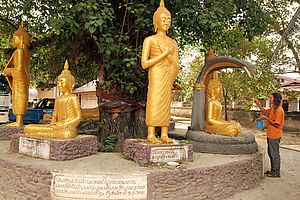 Traditionally, people prepare flowers and perfumed water which is
taken to temples and sprinkled over buddha statues. Some of the
water is carried back home and gently poured on relatives and
friends, to purify them and give a good start for the New Year. This
all still happens and the Buddhist New Year is a beautiful time to
visit a temple, stop for a prayer and do the ceremony following the
locals. We also did.
Traditionally, people prepare flowers and perfumed water which is
taken to temples and sprinkled over buddha statues. Some of the
water is carried back home and gently poured on relatives and
friends, to purify them and give a good start for the New Year. This
all still happens and the Buddhist New Year is a beautiful time to
visit a temple, stop for a prayer and do the ceremony following the
locals. We also did.
 A newer habit is to stand in small groups by the roadside, armed
with a garden hose, buckets and water guns, and to pour or throw
water on everyone who passes by. People in Laos usually drive small
motorcycles, which makes them good targets. Even the majority of
cars are pickups or half-open trucks, with people sitting in the
back unprotected from water. If someone doesn't like to get wet,
it's simply best to stay indoors. Most people don't mind, as it's
part of the New Year and the sun dries everything quickly
anyway.
A newer habit is to stand in small groups by the roadside, armed
with a garden hose, buckets and water guns, and to pour or throw
water on everyone who passes by. People in Laos usually drive small
motorcycles, which makes them good targets. Even the majority of
cars are pickups or half-open trucks, with people sitting in the
back unprotected from water. If someone doesn't like to get wet,
it's simply best to stay indoors. Most people don't mind, as it's
part of the New Year and the sun dries everything quickly
anyway.
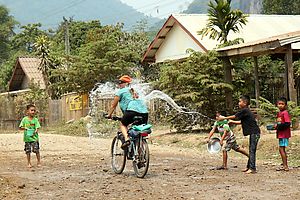 In the gentle and polite version of the New Year greeting, people
first wave the driver to stop. Then they pour a small amount of
water on the neck so that it runs down along the back, accompanied
with a cheerful wish of "Sabai dii Pi Mai", "Souksan van Pi Mai" or
"Suk dii Pi Mai", which translate to "Happy New Year" or "Good
luck for the New Year". If someone has a bag or something else which
shouldn't get wet, it can be lifted up so that no damage is done.
Especially elderly people were mostly greeted this way.
In the gentle and polite version of the New Year greeting, people
first wave the driver to stop. Then they pour a small amount of
water on the neck so that it runs down along the back, accompanied
with a cheerful wish of "Sabai dii Pi Mai", "Souksan van Pi Mai" or
"Suk dii Pi Mai", which translate to "Happy New Year" or "Good
luck for the New Year". If someone has a bag or something else which
shouldn't get wet, it can be lifted up so that no damage is done.
Especially elderly people were mostly greeted this way.
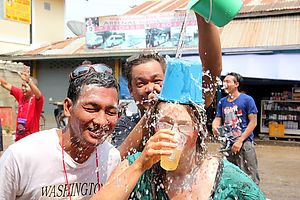 We as young foreigners on bicycles were naturally fair targets for
all variants of the game. Often we got several buckets of water
poured over us, followed by a glass of beer to drink, which we were
expected to finish before being allowed to ride forwards. Children
sprayed us with water guns, sometimes with water coloured in yellow,
green or red. A couple of times we also got white talcum powder
sprinkled on our heads. It was fun to ride around to see and feel
the party.
We as young foreigners on bicycles were naturally fair targets for
all variants of the game. Often we got several buckets of water
poured over us, followed by a glass of beer to drink, which we were
expected to finish before being allowed to ride forwards. Children
sprayed us with water guns, sometimes with water coloured in yellow,
green or red. A couple of times we also got white talcum powder
sprinkled on our heads. It was fun to ride around to see and feel
the party.
 When we wanted to play with water ourselves, we simply stopped at
one of the groups of locals by the roadside. They welcomed us
enthusiastically with an extra dose of water to make sure we'd be
wet enough, we got buckets, a bit of colour to the face and a glass
of beer, and were ready to join the team. So we also poured and
threw water on passers-by, on each other and on everybody around,
wished all Happy New Year and danced to the music. As for the beer,
we tried our best to drink a little bit with everyone while
avoiding to get too drunk. I'd say it worked out quite well.
When we wanted to play with water ourselves, we simply stopped at
one of the groups of locals by the roadside. They welcomed us
enthusiastically with an extra dose of water to make sure we'd be
wet enough, we got buckets, a bit of colour to the face and a glass
of beer, and were ready to join the team. So we also poured and
threw water on passers-by, on each other and on everybody around,
wished all Happy New Year and danced to the music. As for the beer,
we tried our best to drink a little bit with everyone while
avoiding to get too drunk. I'd say it worked out quite well.
 There were also many groups driving around in pickup trucks,
equipped with barrels full of water, buckets, water guns and
sometimes small water bombs. They engaged in water fights with other
pickups and with the teams by the roadside. Even a bigger truck with
a several thousand liter tank of water drove around spraying water
from a big hose. We heard that spraying water directly from garden
hoses and coloured water are actually forbidden, but nobody seemed
to mind. These were joyful water fights where everybody wins.
There were also many groups driving around in pickup trucks,
equipped with barrels full of water, buckets, water guns and
sometimes small water bombs. They engaged in water fights with other
pickups and with the teams by the roadside. Even a bigger truck with
a several thousand liter tank of water drove around spraying water
from a big hose. We heard that spraying water directly from garden
hoses and coloured water are actually forbidden, but nobody seemed
to mind. These were joyful water fights where everybody wins.
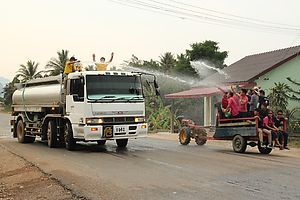 Officially the celebrations lasted for three days, from 14th until
16th of April. Some people started a day or two earlier, but 16th
was really the last day with water play. Eating, drinking and
dancing continued a day or two more, extending the party to a full
week. Most of the activity happened during daytime, from about 10 am
until 5 or 6 pm. In the evening nobody was throwing water any more:
it was time to sit down, eat and drink with friends. Music was
played at all times. In Laos nobody complains about loud music even
at night, especially not during New Year. Still, after 9 or 10 pm
most people went to sleep and it was already relatively quiet.
Officially the celebrations lasted for three days, from 14th until
16th of April. Some people started a day or two earlier, but 16th
was really the last day with water play. Eating, drinking and
dancing continued a day or two more, extending the party to a full
week. Most of the activity happened during daytime, from about 10 am
until 5 or 6 pm. In the evening nobody was throwing water any more:
it was time to sit down, eat and drink with friends. Music was
played at all times. In Laos nobody complains about loud music even
at night, especially not during New Year. Still, after 9 or 10 pm
most people went to sleep and it was already relatively quiet.
 We were impressed by the openness of people welcoming us, even
though we didn't know more than a couple of words of Lao and the
English abilities of our hosts were often on the same level. In
Germany or Finland strangers passing by would not be so easily
invited to join and warmly welcomed to a party. The attitude of the
Lao people was that shared fun is more fun, and everybody is
welcome. That's something we can also try to learn from them.
We were impressed by the openness of people welcoming us, even
though we didn't know more than a couple of words of Lao and the
English abilities of our hosts were often on the same level. In
Germany or Finland strangers passing by would not be so easily
invited to join and warmly welcomed to a party. The attitude of the
Lao people was that shared fun is more fun, and everybody is
welcome. That's something we can also try to learn from them.
Overall, the Lao New Year was one the funniest festivals we've ever been to. People were happy, playful and relaxed, having a good party mood. The water play was sometimes wild, but not rough. If we happen to be in Laos or Thailand (where the festival is called Songkran) in the future at the same time of the year, we'll certainly be on the streets again.
Up and down the mountains in Northern Thailand and Laos
Posted: 2013-04-09 18:58:09, Categories: Travel, Thailand, Cycling, Laos, 1205 words (permalink)
 Our bicycle tour continued to Chiang Mai, the largest city in Northern
Thailand, and further North-East towards Laos. The landscape became
more mountainous and the roads climbed up and down with numerous
sharp curves. The temperatures were pleasantly a bit cooler than in
Central Thailand, due to the higher altitude and the surrounding
hills and mountains. Especially during the nights the temperatures
dropped, making blankets more useful than air condition.
Our bicycle tour continued to Chiang Mai, the largest city in Northern
Thailand, and further North-East towards Laos. The landscape became
more mountainous and the roads climbed up and down with numerous
sharp curves. The temperatures were pleasantly a bit cooler than in
Central Thailand, due to the higher altitude and the surrounding
hills and mountains. Especially during the nights the temperatures
dropped, making blankets more useful than air condition.
About 60 km north-east of Chiang Mai we came to the Bua Tong waterfall. We had seen several beautiful waterfalls a few days earlier in the Doi Inthanon national park, but Bua Tong totally surprised us. The water flowed down the cliffs in relatively small steps, which had a sandpaper like surface with a good grip. Children and adults alike were climbing up and down the falls, playing with the water. We naturally joined the party: a refreshing and fun experience!
 In Chiang Khong we crossed the border over the Mekong river to Huay
Xai, Laos. There we took a break from cycling and joined the Gibbon
Experience, a one and a half day trip to the jungle with
ziplines. Wearing a climbing harness and hanging from a metal wire,
one glides through the forest and above the treetops. It was a
series of exciting rides and great views to the nature at the same
time, with the longest ziplines being almost a kilometer long. The
night was spent in a treehouse, swinging gently in the wind several
dozen meters above the ground. We didn't see any gibbons, but
enjoyed the forest which had some magnificent giant trees. According
to the Gibbon Experience
website, the income of the activity is funding the protection of
the forest. Without deeper knowledge it's hard to say how large a
share truly goes to preservation, and how much building the ziplines
and riding them disturbs the nature, but I do believe it's a more
sustainable business model than logging and burning the forest to
fields.
In Chiang Khong we crossed the border over the Mekong river to Huay
Xai, Laos. There we took a break from cycling and joined the Gibbon
Experience, a one and a half day trip to the jungle with
ziplines. Wearing a climbing harness and hanging from a metal wire,
one glides through the forest and above the treetops. It was a
series of exciting rides and great views to the nature at the same
time, with the longest ziplines being almost a kilometer long. The
night was spent in a treehouse, swinging gently in the wind several
dozen meters above the ground. We didn't see any gibbons, but
enjoyed the forest which had some magnificent giant trees. According
to the Gibbon Experience
website, the income of the activity is funding the protection of
the forest. Without deeper knowledge it's hard to say how large a
share truly goes to preservation, and how much building the ziplines
and riding them disturbs the nature, but I do believe it's a more
sustainable business model than logging and burning the forest to
fields.
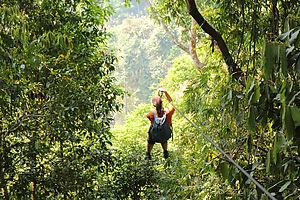 From Huay Xai we continued further east across Northern Laos. The
Lao road network is much less dense than in Thailand, so we couldn't
easily plan a route on secondary roads. Fortunately the main road
number 3 towards Luang Namtha was far from a busy highway, rather
resembling the countryside roads we had been cycling in
Thailand. The population density of Laos is less than a fifth of
that in Thailand, and only few people have cars. Heavily loaded old
trucks and minibuses occasionally unfreshened the air with thick
black clouds of exhaust while passing us, but the traffic density
was low enough not to bother us too much.
From Huay Xai we continued further east across Northern Laos. The
Lao road network is much less dense than in Thailand, so we couldn't
easily plan a route on secondary roads. Fortunately the main road
number 3 towards Luang Namtha was far from a busy highway, rather
resembling the countryside roads we had been cycling in
Thailand. The population density of Laos is less than a fifth of
that in Thailand, and only few people have cars. Heavily loaded old
trucks and minibuses occasionally unfreshened the air with thick
black clouds of exhaust while passing us, but the traffic density
was low enough not to bother us too much.
The road continued to go up and down large hills, with beautiful views down to the valleys on higher passes. The surface was paved and in good condition, a pleasure to ride. The land was partly covered by forest and partly deforested, with mainly Chinese and Vietnamese buying the wood. We saw many small rivers, which were generally cleaner than in Thailand, probably due to almost complete lack of any industry in the area.
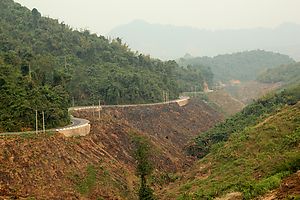 Both Lao and Thai people have a habit to burn patches of land,
often to prepare a field but sometimes with no apparent
purpose. Most of the burning happens between February and April,
which in combination of the long dry period makes the air misty and
dusty, like constantly being inside a thin cloud. It has not been
difficult to breathe but we have certainly felt the difference from
fresh and clear mountain air. We've also missed the blue sky, which
will only appear again when the rainy season begins in May or
June.
Both Lao and Thai people have a habit to burn patches of land,
often to prepare a field but sometimes with no apparent
purpose. Most of the burning happens between February and April,
which in combination of the long dry period makes the air misty and
dusty, like constantly being inside a thin cloud. It has not been
difficult to breathe but we have certainly felt the difference from
fresh and clear mountain air. We've also missed the blue sky, which
will only appear again when the rainy season begins in May or
June.
Roughly every five kilometers the road went through a small village. Children were happily waving and shouting "Hello" or "Sabaidee", often running to the roadside to meet us. They didn't have much but were laughing, playing and seemingly enjoying life. We rarely heard a child crying or anybody shouting in an angry voice. Adults were a bit more reserved but many still greeted us, staring, smiling and wondering why on earth were we pedaling all those uphills by bicycle when also motorcycles had been invented.
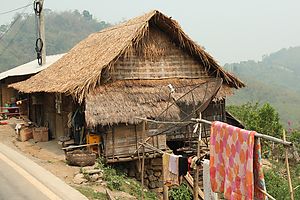 Most of the houses in villages were modest bamboo huts, probably
similar than they've been for hundreds of years, except being
nowadays equipped with electricity, tv and a satellite dish.
Cooking was still commonly done on fire and washing at the village
well. Here and there between the huts appeared fancier newer houses
built from concrete, especially in villages located near bigger
towns. Almost every village also had an elementary school, often
built with the support of some charity organization. That was the
situation in villages next to the main road. Rural villages tucked
between the mountains, many of them accessible only via narrow dirt
tracks, are apparently still less developed.
Most of the houses in villages were modest bamboo huts, probably
similar than they've been for hundreds of years, except being
nowadays equipped with electricity, tv and a satellite dish.
Cooking was still commonly done on fire and washing at the village
well. Here and there between the huts appeared fancier newer houses
built from concrete, especially in villages located near bigger
towns. Almost every village also had an elementary school, often
built with the support of some charity organization. That was the
situation in villages next to the main road. Rural villages tucked
between the mountains, many of them accessible only via narrow dirt
tracks, are apparently still less developed.
We cycled about 400 km from west to east via Luang Namtha and Oudomxay until Muang Khoua, a small town near the Vietnamese border. From there we took a two-day boat ride south on the Nam Ou river, finally joining the Mekong and arriving in Luang Prabang. The ride was very scenic, villages by the riverside only accessible by boat, fishermen, water buffaloes, small rapids, rock formations, sandy beaches and majestic mountains. Between the two days spent in the boat we stayed for two nights in Muang Ngoi, a riverside village transformed into a backpacker hangout as a result of all the boats stopping there. Despite the tourist crowds it was still a quiet and atmospheric place, having no cars and electricity only between 6 and 10 pm produced by a generator. That said, a new electricity line was just being installed and a road being built, which will certainly make a big change.
 In Luang Prabang we went to see some of the well-known sights. The
old and beautiful Xiengthong temple and the Kuang Xi waterfalls 30
km outside the city with idyllic turquoise pools were really worth a
visit. After that we headed again out to the countryside and started
cycling towards Phonsavan. The road was even a bit more mountainous
than earlier parts of our route, making some of the days quite
exhausting. Villages seemed to be a bit wealthier than in the
north, but ironically the first time children came to beg for candy
and money. It didn't happen often, but a few times during our ride
through the region.
In Luang Prabang we went to see some of the well-known sights. The
old and beautiful Xiengthong temple and the Kuang Xi waterfalls 30
km outside the city with idyllic turquoise pools were really worth a
visit. After that we headed again out to the countryside and started
cycling towards Phonsavan. The road was even a bit more mountainous
than earlier parts of our route, making some of the days quite
exhausting. Villages seemed to be a bit wealthier than in the
north, but ironically the first time children came to beg for candy
and money. It didn't happen often, but a few times during our ride
through the region.
Overall the pace of life in Laos is slow, slower than in Thailand. Selection in shops and on the markets is smaller, there is not much effort in arranging things attractively on the shelves and never a push to buy anything. Restaurants are serving more basic food, which however is usually tasty and not too spicy. Nobody seems to be in a hurry to go somewhere. This helps also the traveller to adopt a more relaxed and simple lifestyle. We will see how the atmosphere will change in a few days, during the celebration of Pi Mai, the Lao New Year. In addition to old traditions of cleaning homes and paying respect to the gods, the festivities include some wild partying and water throwing. In these temperatures being sprayed with water is a pleasure, so we're looking forward to joining and getting wet.
Wild elephants on the road
Posted: 2013-03-05 03:27:43, Categories: Travel, Thailand, Cycling, 787 words (permalink)
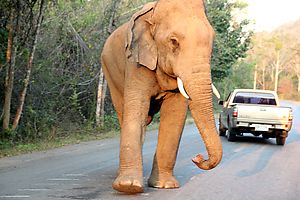 Sandra and I are now in Thailand and this photo shows one of our most exciting
moments during the first two weeks. We were riding a moped back from
Palau waterfall in Kaeng Krachan national park, when suddenly two
big wild elephants were walking towards us on the road. A Thai man
stopped his moped, turned around and adviced us to do the same. We
drove back a couple of hundred meters and watched how the beautiful
animals walked slowly forwards. One of them decided to return to the
forest, the other continued on the road.
Sandra and I are now in Thailand and this photo shows one of our most exciting
moments during the first two weeks. We were riding a moped back from
Palau waterfall in Kaeng Krachan national park, when suddenly two
big wild elephants were walking towards us on the road. A Thai man
stopped his moped, turned around and adviced us to do the same. We
drove back a couple of hundred meters and watched how the beautiful
animals walked slowly forwards. One of them decided to return to the
forest, the other continued on the road.
A car came from our direction and started slowly driving around the elephant. We followed behind the car together with the Thai motorist. Just as the car was passing, the elephant turned and started again crossing the road. The car and the Thai motorist got through, we weren't sure and stopped. Should we get off from the moped and slowly retreat on foot, or what should we do? Fortunately the elephant decided to stay in the middle of the road, leaving us enough space on the side. Sandra held her nerves well enough to point the camera towards the giant and take the photo.
We started our Thailand tour on the 14th of February by flying to Bangkok and taking a bus to Hua Hin. There we visited Sandra's father, who married a Thai woman after the early death of Sandra's mother, and who is now living in Thailand with his new family. In addition to meeting the family, Hua Hin was a good place to get adjusted to the climate, to try out Thai food and delicious fruits, to spend a bit of time on the beach, to enjoy a Thai massage, to visit a few temples and to get used to the left hand side traffic. The trip to Palau by moped was an exception, mostly we rode our bicycles which we brought with us.
After a week in Hua Hin we spent two days in Bangkok, which was a quite hectic experience after the more relaxed Hua Hin. We cycled once across the whole city from the western bus terminal to our hotel, which we had less wisely booked in the eastern part of Bangkok. After that we switched to public transport and walking. Once we rode motorcycle taxis, the fastest way to get around and an experience in itself. Of the most famous sights we went to see the big lying golden Buddha statue at Wat Pho, but skipped the Grand Palace. The backpacker oriented Khao San area was a bit more laid back, including roads without cars, with food stands on the side and foot massages outside in open air. We also shortly met my old friend Phisit, who kindly invited us for lunch near his workplace.
From Bangkok we took a train north to Phitsanulok and started our cycling tour. We rode first to Sukhothai spending one day around old temple ruins, and from there through the countryside and small towns towards Chiang Mai. Now we are at Chom Thong, near Thailand's highest mountain Doi Inthanon and the surrounding Doi Inthanon national park.
Especially smaller roads have been nice and motorists surprisingly polite. Cars and trucks mostly leave a large safety margin when overtaking us — sometimes vehicles coming from the opposite direction have to cope with a much less space than we do. People are yelling "Hello hello" from their houses when we're passing: the smaller the road the more attention we gather. A few times we've got spontaneous gifts such as bottles of drinking water or a watermelon. Unfortunately the locals' English ability is usually limited to the "Hello" and we don't speak enough Thai to really communicate with them.
Daily high temperatures are constantly over 35°C, and the sun shines strongly. We try to start relatively early in the morning and find accommodation latest early afternoon, leaving time to rest during the hottest time and to walk around later in the evening. Hotels and guesthouses are mostly easy to find, and cost around 400 Baht (10€) for a modern and clean room with air conditioning, less with fan only. Two times we stayed with CouchSurfing hosts, enjoying generous hospitality and learning more about the local culture and habits.
Staying connected in Thailand is quite easy nowadays. Almost all hotels and guesthouses have free wireless Internet. And when that's not available, we can use our one month / 1 GB mobile Internet package which we got for 500 Baht including the SIM card and some talk time. Phone calls with Thai SIM cards are cheap too, even when calling abroad. Roaming fees are absurdly high, so our Finnish and German cards we're keeping out of our phones.
Four weeks without sun
Posted: 2013-02-12 03:26:36, Categories: Travel, Norway, 546 words (permalink)
 Sandra and I spent the Christmas and New Year on the small 8 km² island of
Karlsøya, Norway, 400 km north from the polar circle. That's north
enough that in the winter sun remains under the horizon for two
months, and in the summer it shines all around the clock for an
equally long period, at least when clouds are not blocking it. For
us it was the first time being so far north during winter time.
Sandra and I spent the Christmas and New Year on the small 8 km² island of
Karlsøya, Norway, 400 km north from the polar circle. That's north
enough that in the winter sun remains under the horizon for two
months, and in the summer it shines all around the clock for an
equally long period, at least when clouds are not blocking it. For
us it was the first time being so far north during winter time.
Compared to our expectations there was actually a lot of light. We thought it'd be mostly dark, with just a little bit of red in the horizon. But for about four hours each day it was bright enough to call it daylight. First it was an hour long sunrise with all shades of red and yellow, then about two hours of blue sky and after that a one hour sunset. Even at noon we didn't see the sun of course, so it felt a bit strange to see blue sky, sometimes with the moon in the middle of it. Taking photos with automatic white balance settings produced constantly more reddish results than the eye would see. Either the camera software was confused or perhaps our brain partly filtered out the red, hard to say. We tweaked the settings to make the colours as close as possible to what we saw.
On cloudy days it was clearly more dark, and the time one could easily walk outside without a lamp reduced from four or five to about three hours. Clouds also blocked the moonlight, which was quite strong on clear days. Northern lights appeared a few times, but unfortunately only relatively modest green stripes; no multi-coloured show filling the sky.
Another surprise was the temperature. We had not really checked any long term weather forecasts and were prepared for temperatures down to -30°C or so. That was indeed the case 100 km inland, but the coast is so strongly warmed up by the Gulf Stream that extreme temperatures are rare. On Karlsøya it was between 0 and -10°C, on some days even above zero. There was less snow than we had in Southern Germany in December when we left.
We slept inside a building which had earlier been a school and is nowadays mostly used only during a yearly summer festival. With more than 50 people the space was tight, but at least it was warm enough. The program of the gathering consisted of eating, preparing food, discussion circles, workshops, live music, singing, dancing and lazying around. Most of that happened inside, so it was good to also get out and go on walks around the island. That required a bit of attention — it was too easy to stay up until late night, get up late in the morning, have a slow breakfast and miss the daylight completely. Towards the end of our stay it happened to us more and more often.
One of our nicest walks was climbing on top of the nearby hill on December 21, the shortest day of the year. The peak rose to about 200 meter altitude from the sea level. There was a view over whole Karlsøya and towards higher snow-covered mountains on nearby islands in several directions. The midday moon and sunset over the scenery was a beautiful sight.

Copyright Arto Teräs <ajt@iki.fi>, licensed under the Creative Commons Attribution-Share Alike 3.0 Unported License. (Unless otherwise mentioned in individual photos or other content.)